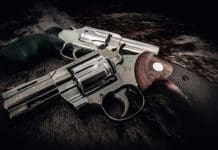[HTML1]
Wow. This guy is fast. Well, he’s fast at clearing a double feed. When the deed is done, BatterieSnare shoots at what can only be called a leisurely pace. After that (:35), he lowers his gun, pulls it in slightly, and glances left and right. He retracts his weapon a bit more and does it again. Then he stands up and scans again. His bird-like head movements are cursory. Perfunctory. Meaningless. At no point did BS actually LOOK at what was on either side of him . . .
I see this at the range all the time. Shoot, retract, fake scan left, fake scan right, re-holster. Double quick.
First, what’s with the near-instant gun retraction? In a military environment, with multiple threats sneaking up you from every direction, weapon retention may be job one. Out on the street, the most likely threat is the same one you just shot. Or someone within your immediate field of view.
Here’s an option: keep your arms extended in the firing position and your head still. Scan with your eyes, searching for trouble whilst looking over the gun. If you need to fire again—at the same target or roughly in the same direction—you can shift your eyes from the target back to the sights in an instant, re-orient the gun left or right (if necessary), and let loose the dogs of war.
After the forward facing scan, I like to bring the gun back as I turn my head left. And then put the weapon into a low ready and turn head and body right. Exactly how and when you pull your gun in and begin your side scan can depend on any number of factors. But best practice is best practice. For example . . .
It’s a good idea to move as you scan. Sitting duck. Standing shooter. Same diff. I would go so far as to say that moving after shooting is more important than rapidly checking your six and nine o’clock positions.
Second, training yourself to glance left and right after a string trains you to glance left and right after a self-defense shooting. Again, what’s the big hurry? Anyone who wants to do you ill after you just shot someone else in self-defense is probably going to . . . wait for it . . . hide. And THEN cap yo’ ass.
What are the chances of seeing a perp hiding during a split second scan? Nil. As I said above, you need to LOOK for trouble. Shoes underneath cars, a head darting out from behind a tree, etc. At the same time, check for cover and concealment.
And that’s yet another problem with training at an indoor or home range: it’s a familiar, sterile environment. There really isn’t anything to look at. You could ask a friend to stand behind you with a playing card, but then you’re training yourself to look for someone holding a playing card.
Hence my desire to train at as many ranges as possible. In any case, force yourself to slow your scan down. Make it real; note your environment. Otherwise, your training technique is working against you, as is so often the case.




Watching the video, I couldn’t stop laughing. What a tool.
Here’s how to look and see and still get in trouble:
http://www.youtube.com/watch?v=tFkWPNJAy14
This is exactly why in our training classes we have one of the assistant instructors moving around behind the line with a sign saying “Left” or “Right” or even “Head” so the students have to scan enough to see the instructor, process what they saw and react appropriately. We know whether or not they scanned properly by seeing what they shot.
RF says: “He retracts his weapon a bit more and does it again. Then he stands up and scans again. His bird-like head movements are cursory. Perfunctory. Meaningless.”
More than that — he’s popping and locking like a scene extra in a Vanilla Ice video. He’s not practicing, he’s performing. He thinks he’s impressing people with his “moves.” This is the usual show-off range commando BS.
I won’t defend this guy too much, but doing ANY sort of “scan” helps you to break the tunnel vision that will occur when you have to shoot an armed threat. At least this guy has had some training, most have none.
“In a military environment” is that the same as ‘combat’? While I agree that he needed to scan more towards his rear on both sides,he needs to lighten up and relax a bit. He looks to unnaturally stiff. As far as his scanning technique,other than what I previously pointed out,he didn’t do too bad. I disagree that you should take a long ‘LOOK’ for trouble. If you spend to much time ‘LOOKING’ behind trees,shoes under cars whatever to one side,you’re gonna get a bullet from the other side because you were taking to long. As a 0311 Marine infantry rifleman I was taught and expected to be able to ‘assess’ my environment quickly and completely in the minimum amount of time as rounds are whizzing by your head. So multiple ‘quick’ environmental scans with the right training works fine for me.
Comments are closed.